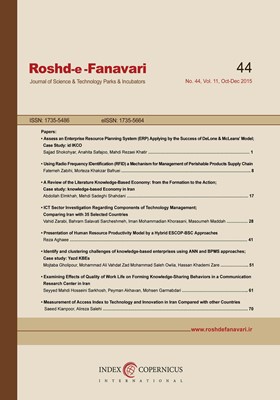Assess an Enterprise Resource Planning System (ERP) Applying by the Success of DeLone & McLean’s Model; Case Study: id IKCO
Subject Areas : مديريت تکنولوژيAnahita Safajoo 1 , Mahdi Rezaei Khatir 2 , Sajjad Shokohyar 3
1 -
2 - Islamic Azad University
3 -
Keywords: Enterprise Resource Planning (ERP), Delone and MacLean Model, Iran Khodro Co (IKCO).,
Abstract :
In today’s dynamic and competitive business environment which is rapidly changing, the development and deployment of modern information systems have received much attention by managers. The use of such systems has left a significant impact on facilitating the management process. Thus, by providing the means of information production, process and distribution among different levels of management, managers have been enabled to monitor the flow of information in their organizations, relying on more knowledge to apply more determined and technical management. To achieve this goal, information systems have been paid due attention while organizations invest heavily in developing information systems. Therefore, it is vital to evaluate the success of information systems in order to understand their value and efficiency and justify the huge amount of investment made in the development of such systems. The present study was aimed at evaluating the success of information systems (Enterprise Resource Planning) in Iran Khodro Company using Delone and MacLean model. A questionnaire was designed based on six criteria including the quality of information, the quality of system, the quality of service, user satisfaction, the use of system and individual impact. The statistical society of research of 25000 people including managers, experts and employees in Iran Khodro car manufacturing company.379 samples were the required sample size, determined from the formula .The research in terms of objective is an applied research and in terms of methodology and implementation is the kind of descriptive analytic research with an emphasis on the correlation branch. First, the variables were described by statistical tables and indices using SPSS. Structural equation modeling was used to analyze data, test hypotheses and generalize the results to population using LISREL. The results of this research show that the acceptance of a system of information, especially from prospective of end users, arising from the ratio between the person and information systems. Finally, solutions have been provided to improve the refuted hypotheses.
1- لگزیان، محمد؛ ارزیابی موفقیت سیستمهای مالی دانشگاه فردوسی مشهد با بکارگیری مدل تعدیل شده دلون و مکلین، فصلنامه علمی پژوهشی پژوهشگاه علوم و فناوری اطلاعات ایران، دوره27، شماره3، ص 577-696، 1391.#
2- موحدي، مسعود؛ عاسبي، مسعود؛ "بررسي تطبيق نقش مديران عالي در پيادهسازي و بكارگيري سيستمهاي اطلاعاتي با تأكيد بر DSS _ در سيستمهاي دولتي ايران و خارج از كشور" دانش مديريت، سال 11، شماره 43، ص 52-24، 1377.#
3- كازروني، مهرداد؛ «راهحل اي.آر.پي، برنامهريزي منابع سازمان سيستمهاي يكپارچه اطلاعاتي مبتني بر فناوري اطلاعات»، (ترجمه: افشين كازروني- محسن شكوري)، نشر ذره، 1381.#
4- آذر، عادل و مؤمني، منصور؛ آمار و کاربرد آن در مديريت، جلد اول، چاپ دهم، تهران: انتشارات سمت، 1380.#
5- خاکي، غلامرضا؛ روش تحقيق در مديريت، مرکز انتشارات علمي دانشگاه آزاد اسلامي، 1383.#
6- آقالرزاده، عمران؛ بررسي آسيبشناسي و اثربخشي اجراي سيستم برنامهريزي منابع بنگاه در صنعت خودروسازي، مطالعه موردي شركت ايرانخودرو، 1391.#
7- بازرگان، عباس و دیگران؛ روشهاي تحقيق در علوم رفتاري، تهران، نشرآگه، چاپ دوازدهم، 1384.#
8- طالبی، محمدرضا و دادفر، رضا، ارائه الگویی جهت انتخاب روش مناسب انتقال تکنولوژی، مطالعه موردی شرکت ایران خودرو.#
9- DeLone, W.H., and McLean, E.R., "The DeLone and McLean of Information Systems Success: A Ten-Year Update," Journal of Management Information Systems, vol.19, no.4, pp. 9-30, spring 2003.#
10- Lucas, H. C., Nielsen, N. R. ”The impact of the mode of information on learning and performance“ Management Science, Vol 26, No 10, PP 982-993, 1980.#
11- Myers, B. L., ” Information systems assessment: development of a comprehensive framework and contingency theory to assess the effectiveness of the information systems function” Published doctoral dissertation, university of north Texas, 2003.#
12- Chandrasekaran, G. Kirs, P. J., ”Acceptance of management science recommendations the role of cognitive styles and dogmatism” Information & Management, Vol 10, N 3, PP 141-147, 1986.#
13- Debrabander, B. Thiers, G. (Successful information systems development in relation to situational factors which affect effective communication between MIS-user and EDP-specialists” Management Science Vol 3, No 2, PP 137-155, 1984.#
14- Livari, J.,” A planning theory perspective on information system implementation “Proceedings of the Sixth International Conference on Information Systems, PP 169-211, 1985.#
15- Robey, D., Zeller, R. F., “Factors affecting the success and failure of an information system product quality“. Interfaces, Vol 8, No 2, PP 70-78, 1987.#
16- Meador, C. L., Guyote , M. J., Keen, P. G. W., ”Setting priorities for DSS development “MIS Quarterly, Vol 8, No 2, PP 117-129, 1984.#
17- Olson, M. H., Lucas, H. C., ”The impact of office automation on the organization: some of implications for research and practice “Communication of the ACM, Vol 25, No 11, PP 847-838, 1982.#
18- Tsai, W.-H. Dept. of Bus. Adm., Nat. Central Univ., Jhongli, Taiwan Lee, P.-L.; Shen, Y.-S.; Yang, C.-C. the relationship between ERP software selection criteria and ERP success, IEEE, 2009.#
19- Nicolaou, A.I., "Firm performance effects in relation to the implementation and use of enterprise resource planning systems", Journal of Information Systems, vol. 18, no. 2, pp. 79-105, 2004.#
20- DeLone, W. H., McLean E. R. systems success: the quest for the dependent variable” Information System Research, vol 3, No 1, pp 60-95, 1992.#

